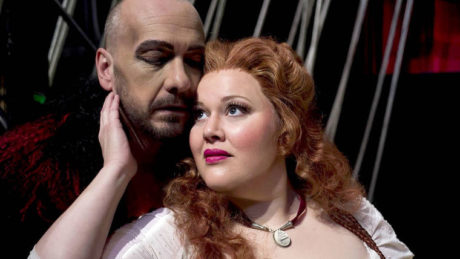How should we deal with the storms of life? Should we go through life content and yet oblivious to the suffering of ourselves and others? Or, do we allow ourselves psychic disturbance over the plight of the world? Should we play the role of Pollyanna or Realist? Should we choose the Red Pill of reality or the Blue Pill of ignorance?

These themes and others played out in the astoundingly well-performed The Flying Dutchman (Der fliegende Hollander) by the Virginia Opera (for the first time in 20 years) at George Mason Center for the Arts April on 23rd. How many ways did I love this show? Numbering them would take hours. My thought throughout was: “My, God, this is art at its best.”
The story can be traced back to at least the 1700s. Years ago, the legend goes, a sailor known as the Dutchman boasted he would sail, unimpeded, forever, and the Devil, who took the Dutchman’s boast as a challenge cursed him to sail the seas in a ghostly ship until Doomsday. The only hope for the Dutchman was being allowed, every seven years, to seek a wife who would be faithful unto death—one who would redeem him. No less than Washington Irving wrote of the Dutchman’s ghostly ship in 1822 “Her appearance was always just after, or just before, or just in the midst of, unruly weather; and she was known by all the skippers and voyagers of the Hudson, by the name of ‘the storm ship.”
Such is the backstory of The Flying Dutchman. Composed by Richard Wagner when he was in his twentied, it is considered Wagner’s first mature opera, and was inspired in part by his own nasty sea voyage, one he took to escape debtors.
The overture was majestic, soul-stirring and hypnotic. It brought me into the world of the Dutchman (the commanding Wayne Tigges in his main stage debut) and his probable savior Senta (the astounding Christina Pier).
Then begins the story: The Steersman (David Blalock) and Senta’s father, ship captain Daland (Peter Volpe) appear. Daland orders his Steersman to seek shelter in the Norwegian port Sandwike Bay to wait out a storm. Supposedly guarding the ship whilst everyone else rests, the Steersman intones a tune and promptly falls asleep, literally at the wheel. The Dutchman’s ship appears, with its red flag and black mast and sets anchor in the bay. Eventually the Dutchman finds his way to Daland’s ship where the two captains meet. In conversation, it comes out that the Dutchman has a fortune in treasure on his ship, with which he will pay for Daland’s hospitality, and learning of Daland’s daughter, asks for her hand in marriage.
Thus the stage is set for the introduction of Senta who has prayed and empathized for years about the legendary Dutchman, doomed to sail the seas forever. As the village maidens sing their “Spinning Song,” Senta is forlorn and pensive, very much Red Pill. She proves to be one of those people who see this sin-sick world for what it is. The maidens however, who happily sing, spin and weave, are either oblivious or nonchalant to the suffering around them; they can’t understand a person like Senta, and neither can Mary, Senta’s nurse (Rachelle Pike), who wonders why Senta spends much of her time looking at a portrait of the Dutchman, who she knows in her heart she can redeem by loving him and being faithful to him forever. When she and the Dutchman finally are introduced by Daland, they are convinced they are one with destiny.
Left in the dust, is Senta’s ex-gentleman caller, Erik (the formidable Corey Bix, also in his main stage debut), a poor hunter. Erik and Senta’s signing argument over her plan to redeem the Dutchman’s soul sets up a love triangle that will play out later.
Next we see a boisterous welcome home party put on by Daland’s sailors and the singing of the joyous “Sailor’s Chorus.” Their celebration is quite a contrast to the Dutchman and Senta’s somber singing—quite brooding are they. Led by Dance Captain Elliot Peterson, the Virginia Opera Dancers gave a rousing performance as the sailors and maidens, with their stomping, stepping, clapping and cheering.
Eventually the aforementioned love triangle plays out, with the Dutchman mistakenly thinking Senta has forsaken him for Erik, causing the Dutchman to flee in rage, but in the end, Senta movingly makes the ultimate sacrifice to ensure she and the Dutchman spend eternity in Heaven.

Tigges gave a commanding performance as the Dutchman. His was the swagger of a modern film action hero. Volpe’s Daland was a bit on the comic side, and Pier’s Senta was simply awe-inspiring.
Conductor Adam Turner and Director Sara Widzer conducted and directed a rapturous two plus hours of Wagnerian bliss. Lighting Designer Mark McCullough made effective use of lighting to create storms and lightening at sea. Set Designer James Noone made brilliant use of several thick ropes, which hung from the rafters stage left and right, to simulate not only the rigging of ships but of the spinning of cloth by the young townswomen. Black ship rigging over a red backdrop evoked the Dutchman’s ship.
Costume Designer Erik Teague clothed the characters in 19th Century attire that evoked the time and place of the opera. Daland in particular looked the part of a Norwegian merchant\seaman from that era, with his top hat and suit\vest combination. Teague made the interesting choice to dress the Dutchman in an unbuttoned fur coat that left Tigges’ tattooed torso exposed—making him stand out all the more.
The Flying Dutchman was a sublime performance that re-created the glory and the splendor and the majesty that is the work of composer Richard Wagner. Let’s hope the Virginia Opera produces Wagner’s unforgettable works more frequently than every 20 years!
Running Time: Two hours and 15 minutes, with oneintermission.
The Virginia Opera‘s The Flying Dutchman ends its run today April 24, 2016 at 2 pm at The George Mason Center for the Arts – 4400 University Drive, in Fairfax, VA. For future events at The George Mason Center for the Arts go to their calendar of events.






Yes, it was an excellent performance, one of the Best of The Flying Dutchman I have seen. I have an advanced degree in Historical Musicology, with and emphasis on Wagner. I have seen this opera performed in Europe, New York, Los Angeles, many times and this performance rivals the best.
My only gripe, and it is a very BIG ONE was the final scene of the opera.
Wagner was one of those composers who wrote highly detailed stage directions for his performers and demanded they be followe with “German precision”.
This production was originally directed by Francesca Zambello, a director who is known to divert from a composers detailed instructions, thinking SHE KNOWS BETTER.
In the thirty plus performances of this opera which I love and I have never seen Senta committing suicide by strangling herself. I looked at several research items I have handy and saw that Wagner directed that Senta be shown “jumping into the depths of the sea”
The entire focus of the opera is changed by the changes in this final scene. Yes the final red graphic did show Senta reaching out to grab the hand of The Dutchman, but in contrast on center stage she is lying dead on a bed.
Zambello has put on other operas in the tradition purist opera lovers like myself call the “euro trash” school, and while in most cases this production was main stream the final scene robbed it of its traditional impact.
I guess for her next production Zambello will try to restage Othello showing Desdemona committing suicide before Othello kills her, or maybe attempt to re write the Old Testament to better fit her orientation.
It is not wise to tamper with a composers intent, especially when Wagner went to the extreme in leaving precise staging instructions. Tradition exists for a reason, and it is not wise to tamer with it.